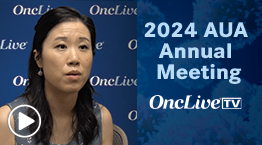Clinical Trials for Relapsed/Refractory mRCC
EP: 1.Introduction and Review of CheckMate 9ER for Metastatic RCC
EP: 2.Review of the COSMIC 021 Study for mRCC
EP: 3.Role of TKI After Progression on I/O for mRCC
EP: 4.I/O Therapy After Progression on I/O for mRCC
EP: 5.Upcoming Combination Trials for mRCC
EP: 6.Clinical Trials for Relapsed/Refractory mRCC
EP: 7.Sequencing After Frontline I/O Based Regimen for mRCC
EP: 8.Emerging Agents for Progressive mRCC
EP: 9.Additional Emerging Therapies for Progressive mRCC
EP: 10.Final Thoughts on the Management of mRCC
Transcript:
Toni Choueiri, MD: Moving to relapsed/refractory metastatic clear cell RCC [renal cell carcinoma], Dr Voss, could you summarize the phase 3 METEOR, CheckMate-025, and the randomized phase 2 of lenvatinib/everolimus? Obviously, the 3 regimens are approved.
Martin Voss, MD: These are studies that led to the development of regimens that have now been on the market for some time. We have to take a detour through the history of kidney cancer and think back to what the landscape was at the time. METEOR and CheckMate-025 were conducted in parallel, essentially in an environment where the standard of care to treat kidney cancer was that of targeted therapies only. Clear cell kidney cancer was predominantly treated with TKIs [tyrosine kinase inhibitors] directed against angiogenesis. But remember that at the time, one of the standards of care in the second-line setting was the oral mTOR inhibitor everolimus. The typical sequence of events at the time would be to treat with a TKI in the first line and then after progression to a second line. Both trials that you referenced, Toni, took aim at that standard approach, and both now try to challenge that second-line gold standard everolimus with then, new agents. One of them was cabozantinib, which we’ve talked about quite a bit today. Cabozantinib was the new kid on the block at the time. The sequence proposed was to give cabozantinib in patients who had received at least 1 TKI. There was no maximum prior lines of therapy in METEOR. They were then randomized to either receive everolimus or cabozantinib. It was the first study in kidney cancer that was able to demonstrate superior overall survival [OS] and progression-free survival [PFS]. It had a novel design of its own going from a PFS end point to a secondary OS end point with an addition of more patients. And both were demonstrated to be superior over everolimus. There was a much higher response rate also. It established cabozantinib as a new standard of care in pretreated kidney cancer.
The second one, which probably had historically the biggest impact of all the studies we've discussed today, was the CheckMate-025 study because it signified the advent of checkpoint inhibitors in kidney cancer. Again, patients who had 1 or 2 TKIs received either everolimus as a standard of care or nivolumab monotherapy. The primary end point for that study was overall survival. This study demonstrated superior overall survival. Secondary end point was higher response rate in the second-line setting for the immunotherapy. Better quality of life data tolerance improved. There was a PFS signal that now we're all very familiar with in that earlier on you didn't really see the benefit immunotherapy. And then with more time, you could see curves separate.
The third study that you mentioned was a bit of an oddball. It was a phase 2 trial that was very well designed with strict inclusion criteria. This was the lenvatinib/everolimus pivotal trial. A phase 2 that enrolled patients in the second- and only the second-line setting. Everyone had to have had 1 TKI and nothing else. And then they were randomized again: standard of care, everolimus; or new TKI, lenvatinib, which is a co-inhibitor of VEGF, FGFR, and other kinases; or the combination of the 2. A 3-arm, 50 patients each, 150-patient total trial. Not a big trial, a phase 2 study that was originally designed as a registration trial. But it ended up showing such a strong signal for the combination that the company was able to take the data to the FDA and was granted approval for the lenvatinib/everolimus combination.
The efficacy data there were going from everolimus to lenvatinib to the combinations. We saw a step-wise increase of not only response rate and PFS, which was the primary end point, but there was also a very strong overall survival signal on that study. And that’s ultimately what convinced the FDA to its approval.
These were the standards that were established in a time when we did not have I/O [immune-oncology] combinations in the first line. The key question, obviously, is now that we have these regimens on the market as on paper, second-line options, how do we apply them in a world where we treat most patients in the front line, at least intermediate/poor risk, with combinations?
Transcript Edited for Clarity



